Having a complete aquarium means you have to set up space for a taste that not only simulates an aquatic creature’s natural environment but also adds some explicit color to the home’s interior. This is where decorating the aquarium with different items, among which aquarium plants are highly significant, becomes crucial. Aquarium plants come in different sizes and have varying characteristics. However, it is good to bear in mind that ‘it is not all that glitters that is gold‘; not all aquarium plants are okay to use in a fish’s tank.
So, in this article, I bring you the 15 best and easy to maintain aquarium plants that you can try out today.
Anubias Nana
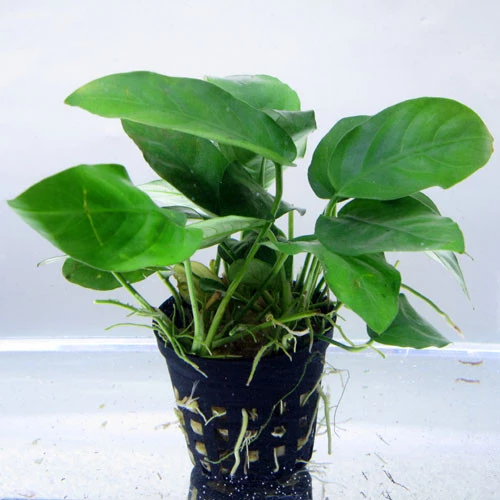
Anubias Nana is a plant with dark-green oval-shaped leaves and rosettes that can measure about 20cm (in length). This plant is known to be a hardy one which is why a lot of beginner aquarists go for it. Though it does propagate to a considerable size naturally [after the stem must have broken off]; the use of a fertilizer can aid the growth to a great extent.
This plant, however, has a rather slow growth rate, and there is an advantage in this as you will not need to trim it very often – one stress off you may say. Beyond this, the Anubias Nana also makes cleaning tankless strenuous as it can help regulate the concentration of nitrate and keep the water oxygenated. Notwithstanding, you still have to avoid getting the tank overloaded with pollutants.
The Anubias Nana can be planted in a finely grained sandy substrate, – but there were occasions where they have been grown on driftwood – and needs moderate lighting to make its food through photosynthesis. By the way; the plant feeds via its root.
Although it can survive a wide range of water conditions – a testament to its hardy nature – it is ideal to keep it in a (water) environment with a temperature range of 22 – 280C with a slightly acidic or slightly alkaline pH value of between 6.0 and 7.5. The water hardness can be between very soft to the very hard range – say 2 – 16dH.
Anacharis
 Known by the scientific name, Egeria densa, Anacharis is yet another hardy plant widely utilized in the home aquarium. The plant is native to the continents of North America and South America. The plant’s floating capability – though it can be planted into a rich substrate – will provide your aquatic pet with some good shade. The plant has a bush green coloration – which is reflected in its leaves and lengthy stem – and this can vary based on water condition. Among the unique features that Anacharis possesses is its set of whorled leaves which may be up to 40 pieces. It is also not unusual to see the plant producing a flower during summer.
Known by the scientific name, Egeria densa, Anacharis is yet another hardy plant widely utilized in the home aquarium. The plant is native to the continents of North America and South America. The plant’s floating capability – though it can be planted into a rich substrate – will provide your aquatic pet with some good shade. The plant has a bush green coloration – which is reflected in its leaves and lengthy stem – and this can vary based on water condition. Among the unique features that Anacharis possesses is its set of whorled leaves which may be up to 40 pieces. It is also not unusual to see the plant producing a flower during summer.
Anacharis is reported to have a rapid growth rate meaning trimming may have to be done regularly. Nonetheless, this plant comes with a whole lot of benefits; for one, it helps to check the growth of algae by absorbing a large number of nutrients and also produces an antibiotic substance that stops the growth of blue-green algae, a bacterium known to produce harmful/toxic substances in water.
Anacharis can thrive in water temperatures between 22 – 26o C, and even at a lower temperature of about 16oC. The appropriate pH range for Anacharis is between 6.5 – 7.5, and the lighting should be moderate.
Hornwort
 Hornwort is a widely distributed freshwater plant that can be found across different continents, and its growth rate is quite rapid. It is yet another tough plant and is sometimes called coontail. It can grow up to a length of 10ft – this is definitely one plant to have in a large home aquarium.
Hornwort is a widely distributed freshwater plant that can be found across different continents, and its growth rate is quite rapid. It is yet another tough plant and is sometimes called coontail. It can grow up to a length of 10ft – this is definitely one plant to have in a large home aquarium.
Hornworts can be found freely floating in still or floating waters, and they can also be loosely anchored, by means of their rhizome, to a substrate. The foliage of hornworts is usually hair-like, and so is the rhizome.
They can grow in different water conditions; from cold water temperature to warm one – about 16oC to 30oC, and water hardness of between 5 – 15dH with a pH value ranging from 6.0 to 7.5. Hornworts require high light intensity [from the sun] to grow, but you can minimize this if you wish to regulate their growth to suit your need.
Besides hornworts being used for decorative purposes, they offer various advantages in the aquarium. For instance, they can provide good shelter for juveniles while growing, and can even help to prevent algal bloom within the tank.
More distinctively, hornworts’ allelopathic quality – which is explained by the production of a chemical that inhibits the growth of other plants within the aquarium – is another reason they are usually used in the home aquarium.
Hornworts can be propagated through a mechanism known as vegetative fragmentation; this entails cutting off the side stem of the plant and then potting it or leaving it to float away from the parent shoot.
Red Ludwigia
Ludwigiarepensis the scientific name of this colorful aquarium plant; it features brightly colored leaves and stems – the color may vary from green to red and orange. The development/emergence of color is, however, dependent on light. Plus, the plant brings forth beautiful yellow flowers at the initial stage of reproduction.
Red ludwigia is capable of growing at a rapid rate under the right condition with its stem being able to attain a maximum length of 51cm. Despite this growth rate, you do not have to trim the plant at frequent intervals, and you could also leverage its ability to grow under a low-light setting if you desire to control its growth. Over and above all, red ludwigia remains a low-maintenance plant to have in the home aquarium.
This plant will appreciate iron-rich (fertilized) substrate and also the addition of CO2 to aid its survival; it is a root feeder. And, it will grow in a water body with a temperature of about 24oC – 26oC and even as low as 15oC. The ideal pH range for cultivating red ludwigia is between 6.5 – 7.5 with the degree of water hardness being within the very soft and moderately hard water range.
To propagate red ludwigia; you should cut off a branch at the top and then plant (the cut-off stem) in an iron-rich substrate. You should get rid of any leaf that may be attached to the bottom to allow proper root development.
Rotala Indica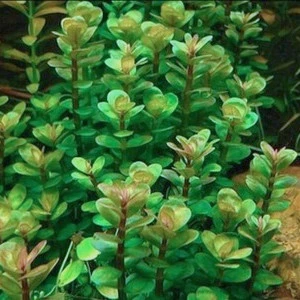
Rotalaindica is native to Indian and Sri Lankan waters, but can also be found in wide distribution in Vietnam, the Philippines, Japan, and China. It is also known as the Indian tooth cup. The leaves, which are oval-shaped, have a mix of pink and green and are usually arranged in such a way that they intersect each other.
It also features flowers that have four triangular sepals and four small pink petals – thus presenting you with a highly decorative item for your aquarium.
Rotala Indica can adapt to a wide range of water environments, but it does have a preference for very soft or hard water – 4 – 12dH – with a temperature range of between 22-28oC, and a pH value of 6.0 and 7.5. It needs a moderate to high light setting with considerable CO2 supplementation to thrive.
One thing you should, however, keep at the back of your mind is that Rotala Indica is a delicate aquarium plant hence it should not be used in a tank housing aggressive fish species like cichlids and Jack Dempseys. It grows very quickly and may need trimming when its appearance starts getting bushy. Rotalaindica will grow in a sandy or finely grained gravel substrate with a good nutrient supply. It can be propagated through stem cutting like the red ludwigia.
Java Fern
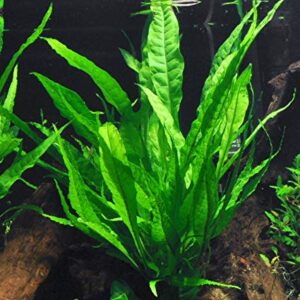 Java fern is an aquarium plant that most aquarists are familiar with as it is sturdy and easy to maintain. It can grow whether wholly or partially submerged in water, and can reach a maximum height of about 34cm – by the way; it does not usually grow at a rapid rate like the previously discussed ones.
Java fern is an aquarium plant that most aquarists are familiar with as it is sturdy and easy to maintain. It can grow whether wholly or partially submerged in water, and can reach a maximum height of about 34cm – by the way; it does not usually grow at a rapid rate like the previously discussed ones.
On its appearance; Java fern has green leathery leaves which may be thin or broad depending on the variety. It also possesses rhizomes which serve as an anchorage that the plant uses to attach itself to the substrate or driftwood within the tank. It is also worth mentioning that matured Java fern often possess tiny black bumps which are somewhat vital for propagation.
Java fern will grow [and thrive] under low to moderate lighting and a small amount of CO2, and do not necessarily require fertilizer; however, it has a great need for oxygen. The appropriate water temperature for Java fern falls between 20oC – 28oCand the pH value should be between the slightly acidic to slightly alkaline – 6.0 – 7.5 – range. The degree of water hardness should be set to within 3dH and 8dH.
To wrap this up; Java fern will be well suited for a nano tank, and it can be propagated through rhizome division or via the development of tiny ‘plantlets‘ off the parent stock.
Brazilian Micro Sword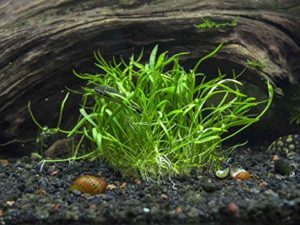
The Brazilian micro sword, which goes by the scientific name Lilaeopsisbrasiliensis, is a short-stemmed aquarium plant, with its maximum height under 10cm; making it fitting for a nano tank. This plant is found in abundance around streams in Paraguay, Argentina, and of course, Brazil.
The Brazilian micros word is known to grow at a slow pace but can eventually spread out like a carpet over the aquarium substrate. This makes it a highly valuable plant for creating hiding places for aquarium pets. Additionally, some fish species may find the shelter provided by the plant useful for keeping their young ones away from prying eyes – or predators to put it straight.
This particular plant needs to be planted in a fertilized substrate as it has a considerable demand for nutrients and CO2 supplementation. Besides, the water in which the plant is growing should be soft or moderately hard and have a temperature of 21 – 28oC with a slightly acidic or slightly alkaline pH value.
High light intensity is also crucial for the survival of the Brazilian micro sword. Still on the care [for Brazilian micro sword]; fish species such as goldfish, scats, tetras, gouramis that can either graze on or dig up the plant should not be housed in the tank wherein the plant had been utilized.
Water Wisteria
Water wisteria is a very hardy aquatic plant that can be seen growing partially or fully submerged in shallow waters. It is native to countries such as Bangladesh, Bhutan, India, and Nepal but yet widely distributed across the globe.

The plant possesses green lace-like leaves [that can modify their shape based on environmental conditions] as well as sturdy dark green stem, and thin white roots which anchor it to a sandy or finely grained gravel substrate. Water wisteria can grow to a maximum height of about 51cm and has a width of 25cm.
It can grow in an upward orientation – rooted in a substrate or spread out like a carpet with the leaves growing on a particular side. This plant can serve a whole lot of purposes in the aquarium; from providing excellent shelter for your aquatic pets to keeping the water oxygenated and giving the set-up a decorative outlook.
Water wisteria is a fast-growing plant that requires an iron-rich substrate and moderates to high light intensity for its development. Furthermore, soft or moderately hard water with a pH range between 6.5 and 7.5, and a temperature between 23 – 28oC is ideal for its growth.
Propagation of water wisteria can occur either through stem-cutting or leaf-cutting.
African Water Fern
 Scientifically named Bolbitisheudelotli, the African water fern is a plant with unique features/characteristics. It has very attractive, transparent leaves as well as rhizome carrying rootlets which it uses to attach itself to rocks, driftwood, and other surfaces.
Scientifically named Bolbitisheudelotli, the African water fern is a plant with unique features/characteristics. It has very attractive, transparent leaves as well as rhizome carrying rootlets which it uses to attach itself to rocks, driftwood, and other surfaces.
The African water fern is found in fast-moving waters with sandy riverbed, and it is known by other common names like creeping fern, African fern, and Congo fern. Despite its widely accepted name, the plant is also widely distributed in some parts of Asia.
African water fern has a slow growth rate with its leaves being capable of attaining a maximum height of about 40cm. However, its growth rate can be boosted with a stronger light setting and good nutrient and CO2 supplementation.
It can be grown on a sandy or rocky substrate – this must be rich in iron and other essential trace mineral elements. Nonetheless, you should be mindful of the fact that excess iron uptake could make the leaves of the Congo fern turn brown.
On the appropriate water parameters for the African water fern; a water temperature within the range of 20 – 28oC and pH value of between 6.0 and 8.5 will be excellent for its growth and development. The degree of water hardness should be between very soft to moderately hard – 4 – 15dH – mark. The nitrate level in the tank should, however, be kept at a minimal level.
Cryptocoryne
Cryptocoryne is an amphibious plant – it can grow in water and on a terrestrial landscape with appreciable moisture contents. It is a tough plant that can be found in waters with a moderate flow rate.
It possesses strong, lengthy white roots that grow underneath the substrate, and leaves that vary in shape – from wavy to spiral, cordate, and so on- depending on the variety (of cryptocoryne) being observed. Some of the commonly used Crypts are Cryptocorynewendtii, Cryptocoryneblassii, Cryptocoryneaffinis to mention but a few.
Crypts are slow-growing plants that can grow to a size of 5-50cm and their size makes them fitting as foreground/mid-ground plants. They should be cultivated in a water environment with a temperature of 20 – 28°C, and pH value ranging between 6.0 and 7.5; the lighting can vary between ‘low-to-moderate setting.
For the substrate; silica sand or finely grained gravel substrate is suitable for their growth; they do not require fertilizer or a high amount of CO2 for their development.
However, they are not so tolerant of substances such as nitrates, phosphates, and carbonates; this means that you will have to put the concentrations of these substances) in check, and also do regular water changes.
And finally, crypts are renowned for shedding off their leaves – a condition commonly termed as ‘crypt melt‘ – so you should take note and not presume that they are dead when this happens.
Moneywort
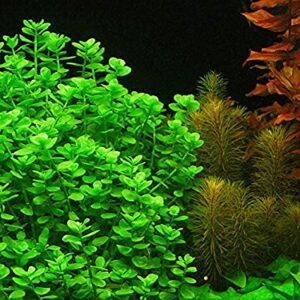 Moneywort is another common plant used in furnishing the aquarium, and hobbyists have come to love it for its hardiness. It is found in wide distribution across different continents except for Antarctica. The plant is also known as Brahmi, Water hyssop, Indian Pennywort, and goes by the scientific appellation, Bacopamonnieri.
Moneywort is another common plant used in furnishing the aquarium, and hobbyists have come to love it for its hardiness. It is found in wide distribution across different continents except for Antarctica. The plant is also known as Brahmi, Water hyssop, Indian Pennywort, and goes by the scientific appellation, Bacopamonnieri.
It can grow to a height of approximately 30cm and is often utilized as a foreground or mid-ground plant. It can be fully submerged in water under the appropriate light setting. The green shiny oval leaves coupled with the vibrant blue flowers of the moneywort will give the aquarium an attractive appearance altogether. It should be noted that the leaves of the moneywort plant are quite fragile; hence, the need to handle with care.
This plant will grow in a nutrient-rich substrate – phosphate and nitrate are highly beneficial for its growth. Plus, CO2 supplementation and clean water are also essential for the health of the plant.
Furthermore, moneywort should be cultivated in a water environment with a pH range of 6.5 – 7.5 with the ideal water temperature being between 22oC and 28oC. The water can be soft or moderately hard, and the light setting can be between moderate level and high level
Moneywort is a stem plant so, it can be propagated through stem cutting or sexual reproduction using the plant’s seeds.
Aponogetonulvaceus
Aponogetonulvaceus is an aquatic bulb plant with some interesting characteristics. This plant, which is native to Madagascar, has several transparent leaves which can exceed 30cm in length. The leaves have a wavy appearance and can be greenish or reddish – the latter coloration being a result of high light intensity.
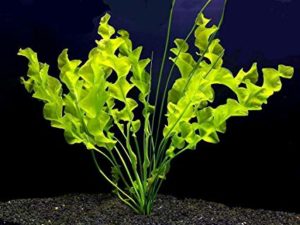
It is quite easy to maintain, and this is why it is often recommended for beginners. Aponogeton can grow at an alarming rate, especially under intense lighting and this means pruning must be done at regular intervals. But, it can also grow under low light intensity; this could serve as a growth-regulating factor.
Aponogetonulvaceus usually grows wholly submerged in moderately moving waters. For aquarium decoration, it can be placed in the mid-ground or background of the tank.
Though it can survive in a wide range of water conditions; the appropriate parameters for its growth should not be overlooked. It grows best at a temperature range of between 22oC – 28oC and a slightly acidic or slightly alkaline pH value between 6.0 – 7.5; soft or moderately hard water will be suitable for its growth.
Aponogeton does not have a high demand for CO2 supplementation, but it needs to be grown on a substrate with a good nutrient supply. For the lighting; low to moderate light intensity will do.
Java Moss
 Java moss is a very versatile plant that many aquarists – beginners and experts – have come to appreciate over the years. The plant can be used to form trees, walls, and carpets to give the aquarium a beautiful outlook. But beyond the aesthetic thrill, its ease of use and hardiness are other reasons for its wide acceptance.
Java moss is a very versatile plant that many aquarists – beginners and experts – have come to appreciate over the years. The plant can be used to form trees, walls, and carpets to give the aquarium a beautiful outlook. But beyond the aesthetic thrill, its ease of use and hardiness are other reasons for its wide acceptance.
The plant is native to Southeast Asia where it grows underwater while being attached to different substrates or platforms – from rocks to driftwood and so on. Java moss has oval-shaped leaves and rhizomes with which it anchors itself to the substrate.
Java moss will thrive in an aquatic environment with a temperature between 18oC and 30oC, and a slightly acidic or slightly alkaline pH range. It can grow under low and high light intensity, but this (that is, the light setting) will undoubtedly affect its appearance. Note that intense light may encourage the growth of algae in the tank. And it does not have much need for fertilizer and CO2 supplementation.
The possibility of Java moss blocking up the aquarium filters [thereby hindering the process of filtration] as well as its tendency to cause algal bloom may pose a significant challenge. Owing to this, you should ensure that you maintain moderate lighting and also see to it that the water is clean and clear.
Guppy Grass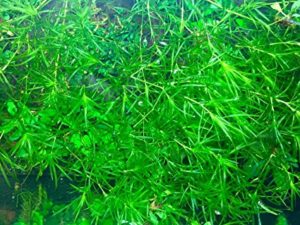
Here is another stem plant that is most times chosen for the hiding spots it creates for aquatic pets [especially juveniles] – this is the very reason aquarists find it useful in shrimp tanks. It is known by the scientific name, Najasguadalupensis, and is sometimes called “common water nymph“.
Apart from providing a good make-shift hatchery/breeding ground for young aquatic species guppy grass also offers tremendous benefits in ridding the aquarium of toxins.
Guppy grass is a fast-growing plant that is quite easy to maintain; it is capable of attaining a maximum height of 90cm.
It will grow in a tank with a low to moderate (water) flow rate. By the way; guppy grass is usually found in still waters and swampy Wetlands. This particular plant does not need CO2 for its growth but will thrive in a waterbody with a temperature between 22°C and 28°C, and a pH value between 6.0-7.5.
The lighting should be set to within the ‘low-moderate range for ease of maintenance. It is worth mentioning that this plant feeds through the water columns. Guppy grass can be rooted to a substrate or may be seen floating, and it can be propagated through stem cutting.
Amazon Sword
Finally, on this list is the Amazon sword, a plant that has become popular among aquarium hobbyists and is often used as a background plant. The plant possesses a short stem, relatively slow-growing, and very strong rhizomes. It grows partially or fully submerged in water.

Amazon sword is not a plant for the nano tank as it can grow to a maximum height of approximately 50 cm. Plus, it is a slow-growing aquarium plant that may not even have any need for CO2 supplementation, but it does require an iron-rich substrate
Furthermore, it will develop well in an aquarium with a temperature of between 22°C and 28°C and a pH range between 6.5 and 7.5 while the degree of hardness can fall within the soft or medium-hard range. Also, the lighting should be moderate. Amazon sword can be cultivated in finely grained gravel substrate – or any loose substrate that will allow easy root penetration.

